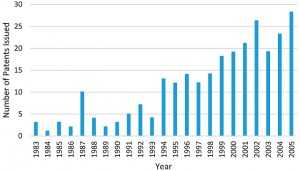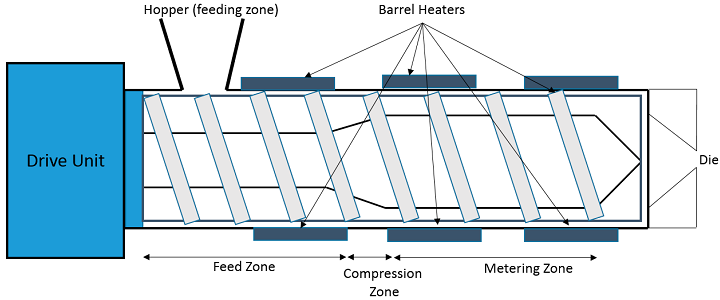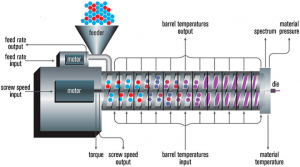We’ve often seen 3D printing used to make drug delivery systems, but a trio of researchers from the University of Sussex are combining FDM technology with something called Hot-Melt Extrusion, or HME, to do the same. Deck Khong Tan, Mohammed Maniruzzaman, and Ali Nokhodchi, from the university’s Pharmaceutics Research Laboratory, recently published a paper, titled “Advanced Pharmaceutical Applications of Hot-Melt Extrusion Coupled with Fused Deposition Modelling (FDM) 3D Printing for Personalised Drug Delivery,” that details their work.
The abstract reads, “The most common 3D printing technology is called the Fused Deposition Modelling (FDM) which utilises thermoplastic filaments as a starting material, then extrudes the material in sequential layers above its melting temperature to create a 3D object. These filaments can be fabricated using the Hot-Melt Extrusion (HME) technology. The advantage of using HME to manufacture polymer filaments for FDM printing is that a homogenous solid dispersion of two or more pharmaceutical excipients i.e., polymers can be made and a thermostable drug can even be introduced in the filament composition, which is otherwise impractical with any other techniques. By introducing HME techniques for 3D printing filament development can improve the bioavailability and solubility of drugs as well as sustain the drug release for a prolonged period of time. The latter is of particular interest when medical implants are considered via 3D printing. In recent years, there has been increasing interest in implementing a continuous manufacturing method on pharmaceutical products development and manufacture, in order to ensure high quality and efficacy with less batch-to-batch variations of the pharmaceutical products. The HME and FDM technology can be combined into one integrated continuous processing platform. This article reviews the working principle of Hot Melt Extrusion and Fused Deposition Modelling, and how these two technologies can be combined for the use of advanced pharmaceutical applications.”
HME technology was originally developed in the 1930s to manufacture plastics and rubber products, but more interest has been developing since the 1980s in its use in the pharmaceutical industry, as the technology can also be used to produce filaments for FDM 3D printing – perfect for drug delivery systems.
Active pharmaceutical ingredients (APIs) are blended with a thermoplastic polymer, then extruded as filaments. It’s a continuous process that applies pressure and heat to melt, or soften, materials through an orifice in order to create new products which possess uniform density and shape.
Extrusion itself can change a substance’s physical properties when it’s forced through a die or orifice, under controlled conditions, on the hot-melt extruder, which contains heaters for melting the materials and is one of the main components of HME; others include a motor, an extrusion barrel, and rotating screws inside the barrel.
The researchers explained, “The screws in the extruder can provide shear stress and intense mixing of the materials. The friction created by the screws in the barrel and the heat provided cause the polymeric material to melt. The screw then conveys the melted material down the barrel. The extruder is controlled through a central electrical control, which is connected directly to the extrusion unit. Some of the processing parameters that can be controlled are screw speed in revolutions per minute (RPM), feed rate, temperature along the barrel and the die, and the vacuum level for devolatilization.”
Because the HME process is flexible and can meet regulatory requirements in the manufacturing of dosage forms, it’s now used quite often in pharmaceutical applications.
“During the hot-melt extrusion process of pharmaceutical dosage forms, APIs, thermoplastic polymeric carrier and processing aids such as plasticisers and antioxidants, are heated and mixed in the extruder and then being forced through a die into shapes including granules, cylinder or films,” the researchers wrote. “In recent years, much work has proven that HME has the ability to improve the solubility and bioavailability of poorly soluble drugs.”
Pairing the technology with FDM 3D printing can help increase the range of usable FDM polymers, improve the usability of FDM 3D printers across many industries, and ultimately streamline the complex processes of conventional manufacturing methods for pharmaceutical products.
“The powerful processing technology of HME has also attracted much attention in developing different types of drug delivery systems, as it has opened up the opportunity to use some of the molecules that were previously seemed not suitable to be made into pharmaceutical dosage forms,” the researchers wrote. “Its ability and efficiency in producing solid dispersions has also made it possible for the development of sustained, modified and targeted drug delivery systems. The different drug release systems can be achieved by controlling the formulations and the processing parameters when using HME.”
HME, which does not require the use of a solvent, can be used to make drugs with a less bitter taste, while also lowering production times and increasing process efficiency. But the the process is not without its issues – it requires high energy input for shear forces and the extruder barrel’s elevated temperature, which can cause thermal degradation of the APIs. But, research is ongoing to solve these issues by using different engineering approaches, along with proper equipment design and formulation.
“The advantages of using FDM in the production of pharmaceutics include design flexibility, cost-effectiveness and high reproducibility. As FDM takes thermoplastic filaments as printing materials, the filaments can be produced using HME. Drug loaded filaments can be extruded from the HME and then fed directly to the FDM 3D printer. Therefore, the HME technology and FDM can be combined into a single continuous process for higher efficiency,” the team concluded. “The combined process provides an automatic production process and could limit material loss. When these two technologies are coupled into one single process, it opens up the possibility of creating any dosage forms in-house for immediate consumption. This is particularly useful for hospitals in remote areas.”
Discuss this and other 3D printing topics at 3DPrintBoard.com or share your thoughts below.
Subscribe to Our Email Newsletter
Stay up-to-date on all the latest news from the 3D printing industry and receive information and offers from third party vendors.
You May Also Like
Further Understanding of 3D Printing Design at ADDITIV Design World
ADDITIV is back once again! This time, the virtual platform for additive manufacturing will be holding the first-ever edition of ADDITIV Design World on May 23rd from 9:00 AM –...
3D Printer Maker EVO-tech Reborn as NEVO3D — Once More With Feeling
EVO-tech was a 3D printing service and original equipment manufacturer established in 2013 and based in Schörfling am Attersee, Austria. The company produced high-quality material extrusion systems featuring linear bearings,...
3D Systems Brings 3D Printed PEEK Cranial Implant to the U.S. with FDA Clearance
For more than 10 years, 3D Systems (NYSE:DDD) has worked hand-in-hand with surgeons to plan over 150,000 patient-specific cases, and develop more than two million instruments and implants from its...
CDFAM Returns to Berlin for Second Annual Symposium
The second CDFAM Computational Design Symposium is scheduled for May 7-8, 2024, in Berlin, and will convene leading experts in computational design across all scales. Building upon the first event...



































